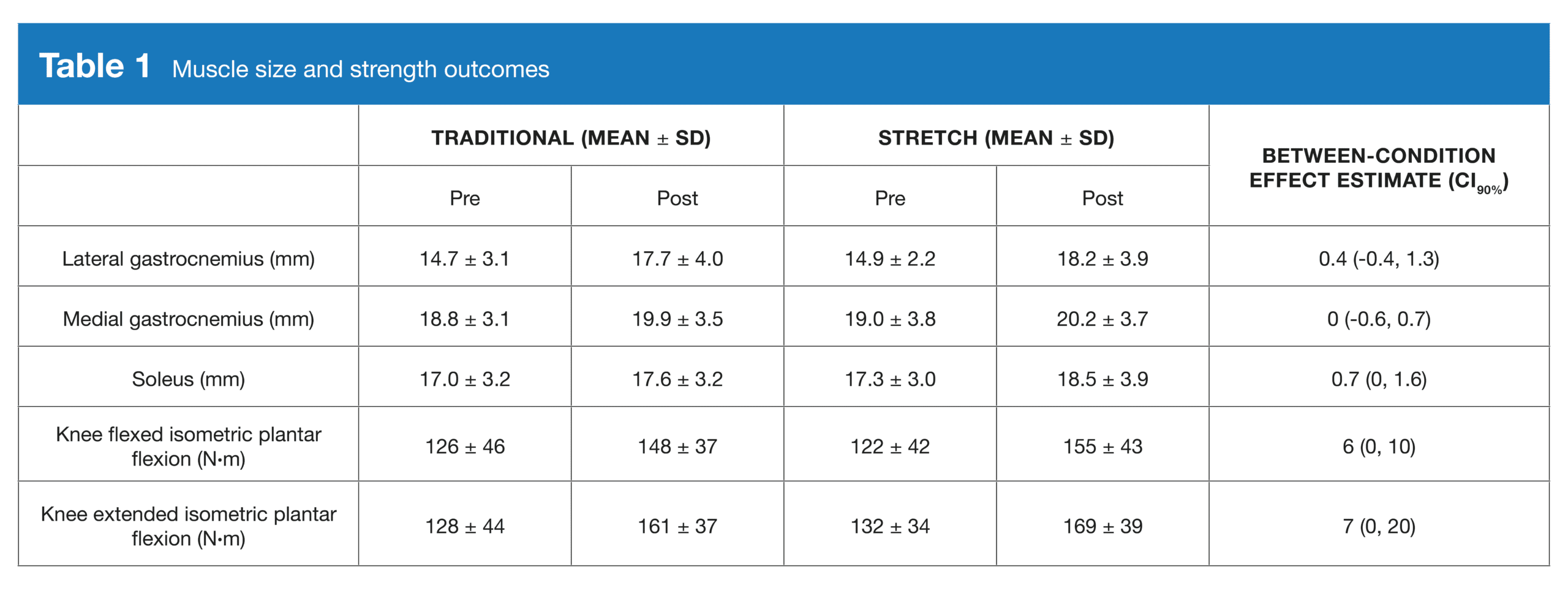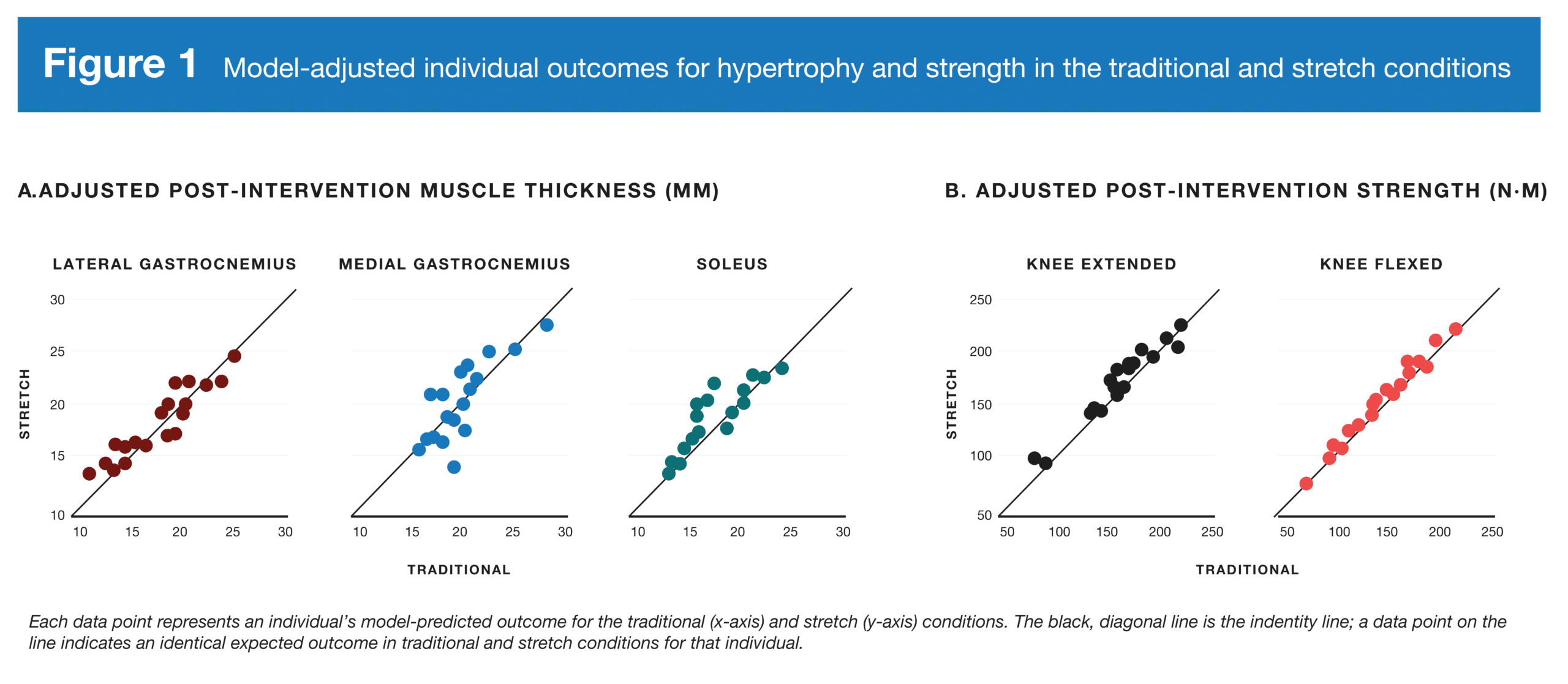Back in Volume 3 of MASS Research Review, I reviewed a study suggesting that agonist muscle stretching between sets could increase muscle growth (2). However, a study reviewed in Volume 5 had contradictory findings, suggesting that inter-set stretching didn’t increase muscle growth (3). There were several differences between the studies, including the muscles assessed (the first study assessed hypertrophy of the biceps, triceps, and quads; the second study assessed pec growth), the subject characteristics (the first study used untrained subjects, while the second study used trained subjects), and the method of stretching (the first study used unloaded static stretches, whereas the second study used loaded stretches). So, it was difficult to pinpoint a reason for the differing findings.
A new study by Van Every and colleagues provides us with more data, but still leaves us with more questions than answers (1).
In this study, 21 young, untrained males completed an eight-week training intervention. This study employed a within-subject unilateral design, meaning one leg (assigned randomly) completed one training program, while the other leg completed a slightly different training program. Both programs involved two weekly calf training sessions, consisting of four sets of seated calf raises and four sets of straight-legged calf raises (on a leg press machine) in each session. Subjects rested for two minutes between sets, and three minutes between exercises. Each set was performed to momentary concentric failure; training loads were decreased if subjects completed fewer than eight reps in a set, and were increased if subjects completed more than 12 reps in a set. The only difference between the two programs involved the presence or absence of inter-set stretching. One leg passively rested between sets. The other leg settled into a 20-second loaded stretch (with the same load used in the preceding set) immediately after each set.
Muscle thicknesses of the medial gastrocnemius, lateral gastrocnemius, and soleus were assessed before and after the eight-week training intervention. Maximal isometric plantar flexion strength (in both a flexed-knee and extended-knee position) was also assessed pre- and post-training.
Inter-set stretching ultimately resulted in more soleus growth (1.2 vs 0.6mm), and slightly more lateral gastrocnemius growth (3.3 vs. 3.0mm); the present study didn’t use traditional null hypothesis significance tests, but neither of these differences would have cleared the typical threshold for statistical significance. Growth of the medial gastrocnemius was similar following both protocols. Strength gains were slightly larger in the inter-set stretching legs, but the difference between conditions was pretty small (Table 1, Figure 1).


When interpreting the present study in light of the two prior studies on the topic, it’s still unclear whether inter-set stretching increases muscle growth in any generalizable sense. Even in the prior study with results that broadly favored inter-set stretching (2), four muscles were assessed (biceps, triceps, rectus femoris, and vastus lateralis), and inter-set stretching only led to a significant difference for one of the muscles (the vastus lateralis). Furthermore, all between-group effect sizes were trivial-to-small in magnitude.
If you want to take a “glass half full” approach to interpreting this small body of literature, you could point out that two out of three studies broadly lean in favor of inter-set stretching increasing muscle growth (albeit weakly), and the third study doesn’t lean against inter-set stretching. Thus, you could credibly argue that, with weak evidence in favor of inter-set stretching, and no direct evidence against inter-set stretching, it’s worth employing inter-set stretching if your goal is to maximize muscle growth.
If you want to take a “glass half empty” approach to interpreting this small body of literature, you could point out that none of these three studies is a slam dunk for inter-set stretching, and the two studies that somewhat support the practice both used untrained lifters. So, you might argue that if you’ve already got a bit of training experience, there’s no reason to suspect that inter-set stretching will improve your hypertrophy results. Furthermore, you could point out that there may simply be better ways to spend your time between sets (4).
My personal take is currently closer to the “glass half empty” interpretation, but I’ll keep an open mind. Ultimately, whether inter-set stretching increases muscle growth is still a wide-open question, and I look forward to seeing more research on the topic in the future.
Note: This article was published in partnership with MASS Research Review. Full versions of Research Spotlight breakdowns are originally published in MASS Research Review. Subscribe to MASS to get a monthly publication with breakdowns of recent exercise and nutrition studies.
References
- Van Every DW, Coleman M, Rosa A, Zambrano H, Plotkin D, Torres X, Mercado M, De Souza EO, Alto A, Oberlin DJ, Vigotsky AD, Schoenfeld BJ. Loaded inter-set stretch may selectively enhance muscular adaptations of the plantar flexors. PLoS One. 2022 Sep 1;17(9):e0273451. doi: 10.1371/journal.pone.0273451. PMID: 36048793; PMCID: PMC9436038.
- Evangelista AL, De Souza EO, Moreira DCB, Alonso AC, Teixeira CVS, Wadhi T, Rauch J, Bocalini DS, Pereira PEA, Greve JMD. Interset Stretching vs. Traditional Strength Training: Effects on Muscle Strength and Size in Untrained Individuals. J Strength Cond Res. 2019 Jul;33 Suppl 1:S159-S166. doi: 10.1519/JSC.0000000000003036. PMID: 30688865.
- Wadhi T, Barakat C, Evangelista AL, Pearson JR, Anand AS, Morrison TEA, O’Sullivan J, Walters J, Souza EO. Loaded Inter-set Stretching for Muscular Adaptations in Trained Males: Is the Hype Real? Int J Sports Med. 2022 Feb;43(2):168-176. doi: 10.1055/a-1529-6281. Epub 2021 Aug 10. Erratum in: Int J Sports Med. 2021 Sep 28;: PMID: 34375990.
- Latella C, Grgic J, Van der Westhuizen D. Effect of Interset Strategies on Acute Resistance Training Performance and Physiological Responses: A Systematic Review. J Strength Cond Res. 2019 Jul;33 Suppl 1:S180-S193. doi: 10.1519/JSC.0000000000003120. PMID: 30946261.




